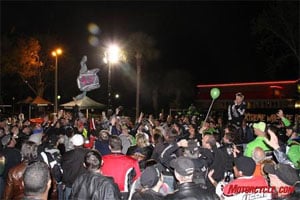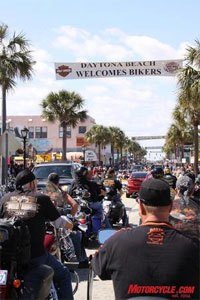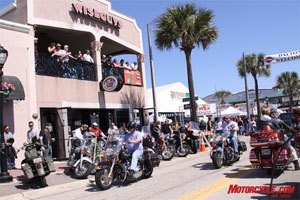While no one will publicly declare alcohol consumption and motorcycling are OK, there remain definite problems in a culture offering mixed messages.Despite campaigns to raise awareness that drinking and riding don’t mix, the incentive to consume alcohol and ride a motorcycle has done anything but gone away.
Included in the allure is a sometimes quietly accepted, revenue-generating subculture enabling such behaviors as riding to the bar, or bar hopping, or participating in massive regional rider festivals where drink (and sometimes drugs) are plentiful.
Or, it could be simply individuals who ride after drinking for their own reasons.
To be fair, some more progressive and safety-minded motorcycle clubs have a rule that no alcohol may be consumed until the side stands are down for the night.
But even so, drinking and riding is more than a blip on the radar screen for transportation safety officials. About 46 percent of riders killed in accidents, according to the Motorcycle Safety Foundation (MSF), have alcohol in their system at the time of their death.
According to the National Highway Traffic Safety Administration (NHTSA), motorcyclists involved in fatal crashes are 2.5 times more likely to have consumed alcohol than passenger vehicle drivers.
In 2007, the number of alcohol-impaired motorcyclists in fatal crashes increased by 10 percent while the number of alcohol-impaired drivers of passenger cars declined 6 percent.
NHTSA defines “alcohol impaired” for vehicle operators over 21 with Blood Alcohol Content (BAC) measured over the 50-state legal limit of 0.08 grams/deciliter.
As in previous years, the 2007 analysis of motorcycle riders and passenger vehicle drivers killed showed about 83 percent of the alcohol-impaired accident fatalities were males.
Recreational riding and recreational drugs, unfortunately, may be seen as compatible, including by those already predisposed to have alcohol problems.
According to Kelley Tway, media relations manager for Mothers Against Drunk Driving (MADD), drinking and driving for car and motorcycle operators is habitual. Tway said first offenders surveyed after being arrested for drunk driving anonymously admitted they had gotten away with drinking and driving an average 87 times prior to being caught.
The statistically worst time periods for those who drink and ride are nights and weekends. These are when the bulk of the crashes happen. In 2007, about 57 percent of alcohol-impaired operators (motorcycle and car) were killed in weekend crashes. Most died between 6 p.m. and 9 p.m.
Responding to these and more troubling statistics, the MSF continues its efforts at attempting to wake up riders to the "pure folly" of riding with alcohol in their bloodstream. There is no safe recommended limit, according to the MSF Director of Special Projects, Ken Glaser. He advises “zero” BAC.
The MSF estimates that even the least amount of alcohol increases a rider's chance of crashing five times. And a (still potentially legal) BAC over 0.05 percent increases chances to crash 40 fold.
While there have been fewer studies for motorcycle riders than for auto drivers, alcohol use and riding are known to be a lethal, self-deluding combination. With a BAC as low as 0.01 to 0.04 percent, riders’ judgments are reduced, while at the same time, they become less critical of their own actions.
With inhibitions diminishing, and sensory stimuli affected by the alcoholic buzz, anecdotal accounts suggest some might even think riding feels more fun as their qualifications to do so continue to dangerously degrade.
From 0.05 to 0.07 percent, thinking and reasoning powers further diminish, and ability to perform complex skills continues to decrease. By the time the legal limit of 0.08 percent is crossed, reasoning powers are severely hampered, and even common simple tasks are done with errors.
A study performed last year by the University of Minnesota Center for Transportation Studies confirmed a BAC within the legal limit of 0.05 percent affected performance.
Riders on outrigger-equipped bikes that could not fall experienced measurably decreased abilities on a controlled test course after only one or two drinks.
While some riders studied could realize when alcohol was affecting performance, the researchers concluded trying to “self regulate,” or be extra careful was no guaranty of not crashing.
A scary reality
Some riders continue to think they can handle alcohol, as evidenced by bikers who ride to bars, and other phenomena in the American motorcycle scene. This is not exclusive to cruisers, or any particular lifestyle. Some sportbike riders, especially relatively younger ones, may hop on their crotch rocket after having a drink or two – or several.
Their decreased abilities, which they cannot adequately judge, combined with decreased sense of inhibition, may yield an increased sense of (false) confidence. While riders may typically try to be careful, anecdotal accounts of those who feel the thrill of ripping through several gears well over 100 mph while drunk are not unheard of.
In the mid-90s, NHTSA conducted focus groups of 70 men and 15 women who admitted they drank and rode motorcycles.
NHTSA stressed these interviews could not be used to draw conclusions for a larger group, but they revealed at least some people entertain seriously sketchy attitudes regarding drinking and riding.
For example, one motorcyclist from Denver said a little alcohol improved his riding.
“I know that when I ride and I have a beer it feels better riding. It loosens you up – it relieves tension,” he said, “It feels more exciting riding. You enjoy your ride better if you have one beer.”
A particular belief was that even if a rider has had several drinks, if he could at least start the motorcycle and get it moving, he would be fine.
”If you don’t fall down within the first few feet, you’re going to be okay,” said the rider from Denver, “I’ve seen guys do that. There’s something about being on a motorcycle – you focus yourself. When you get on your motorcycle and hit the road, the wind and the air just seem to go, “Boom, I’m okay now.”
And another rider from Boston concurred.
“If they’re totally wasted, then you worry about their safety,” he said, “If they’re just a little bit wasted then it’s, ‘Watch out for the cops.’”
Other misconceptions among these riders were that 0.08 percent BAC may barely be a problem, and some said it usually was not the rider’s fault, but another motorist’s, if a crash happened.
While depending on your experience, you may find such accounts incredible, foolish, not applicable to you, or all of the above, it is nevertheless true that some riders think and do dangerous and crazy things.
Why? No doubt more studies are needed for conclusions, but it seems apparent that culturally held attitudes continue to be problematic.
If nothing else be warned: Don’t listen to influences to drink and ride, and never allow yourself to compromise for any reason.
Jeff Cobb is the editor and publisher of Motorcycle Safety News. Comments, and questions can be directed to jeff@motorcyclesafetynews.com.


















